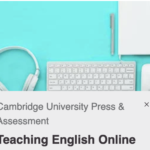EAP: Teaching Effective Thinking Introduction
The World Economic Forum identifies four capabilities 21st century students require:
- Critical thinking / problem solving
- Creativity
- Communication
- Collaboration
These skills are sought after in the Arts, the Sciences, Business, Education, everywhere, really.
My summer pre-sessional students preparing for university in the UK for the final year of their first degrees or for postgraduate degrees, tell me that creative and critical thinking and groupwork are not part of their university experience at home. Not only do they face the challenge of English-medium studies here, they are also expected to think (or at least, express their thinking) differently, to contribute to discussions in seminars, collaborate with other students and give presentations of their work.
I’ve been wondering how far is it possible to teach creative and critical thinking. The following is largely based on FutureLearn courses ‘Unlocking the Creative Brain‘ produced in conjunction with Central Queensland University and ‘Using Creative Problem-Solving‘ developed with the National Yang Ming Chiao Tung University.
What is creativity?
Sir Ken Robinson defines creativity as the ‘process of having original ideas which have value.‘ He draws particular attention to three words in that definition:
- It’s a process. It takes time. It involves false starts and failures.
- It’s original to the person who is creating. It may or may not be original to the world as a whole.
- It has value. It has a worthwhile purpose for whatever reason. He makes a distinction between creativity (a dynamic act) and imagination (a passive act).
Myths
There are various pervasive myths about creative thinking. The two I was particularly interested in were:
- That people are either born with a creative capacity or not.
- That creativity belongs to the right hemisphere of the brain.
Neuroscience has discovered that neither of these beliefs are true.
1. All humans have the potential for creativity. We are naturally creative creatures.
2. The processes required for creativity are ‘split across all lobes and hemispheres of the brain’. Neuroscience has identified the regions involved through use of brain imaging, and offers valuable insight into what we can do as teachers to exercise those processes.
Critical and creative thinking
Critical, or ‘convergent’, thinking is analytical, reflective and evaluative, it is necessary for testing ideas and decision-making. Divergent thinking is explorative, associative and playful, it is necessary for making new ideas. ‘Creativity requires both creative cognition, or divergent thinking, (to come up with ideas) and more critical, or convergent, thinking (to test ideas)’ but we tend to be better trained in convergent thinking. Some people use the term ‘effective thinking’ to embrace both creative and critical thinking, treating them as interdependent, as they actually are.
Brain Processes Involved in Creativity
Onarheim and Friss-Olivarious (2013) identify 5 key concepts based on basic brain processes which relate to our capacity to be creative. They are:
- Priming
- Close and remote association
- Fixation
- Inhibition
- Incubation
Priming is the activation of schemata. Although it activates stereotypical associations, it can be used to encourage new ideas through what has been termed ‘achievement priming’. More on this later.
Close and remote association describes how our brains link ideas. This is connected to what is termed the ‘Space of Possibilities‘. Our ability to link different concepts depends upon the store of knowledge and experience we have, this is our ‘space of possibility’. Our brains do not make giant leaps, they make small steps from idea to idea. The larger our space of possibility, the wider our experience or knowledge, the more associations we can make.
Fixation is a characteristic of convergent thinking. Fixating on one thing leads to a smaller number of ideas. To be creative we need to find ways to leave an idea behind and move on.
Inhibition, while good at refining ideas, is less useful in coming up with ideas. In the initial stages of creativity we need to find ways to remove inhibitory control. Games and humour are good for this.
Incubation is another word for daydreaming or mind-wandering. We need to allow silence or breaks from a task in order to let our subconscious mull the issue at hand.
How can we encourage creativity in class?
There are a number of ways we can use these findings to ‘teach’ effective thinking, many of which underpin accepted EFL practice. Generally speaking it is important to encourage a supportive atmosphere, one in which students feel comfortable and accepted, to help remove affective filters and release inhibitory control. Group work in a supportive atmosphere helps enlarge students’ space of possibilities by drawing on collective knowledge and experience. There are a number of ways in which group work can be set up to maximise divergent thinking and build a more cooperative, creative spirit. I’m currently planning blog posts on brainstorming and brainwriting and Edward de Bono’s ‘Six Thinking Hats’ which explores these. I’m also planning to share some of the tried and tested games and warmers I use which encourage remote association, adopting different perspectives, reducing fixation and priming.
As always, I’d be interested to know what you understand about creative and critical thinking and how you promote them in class.









Leave a Reply
Want to join the discussion?Feel free to contribute!